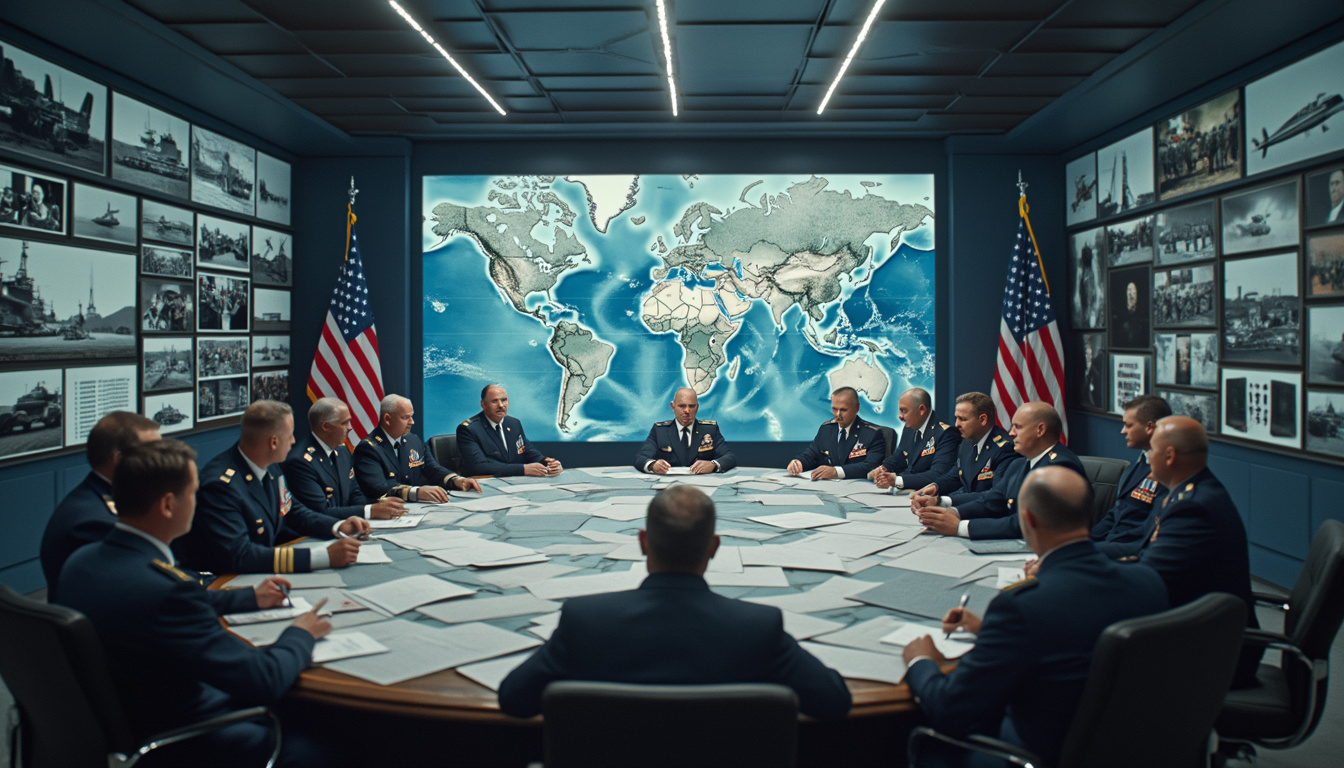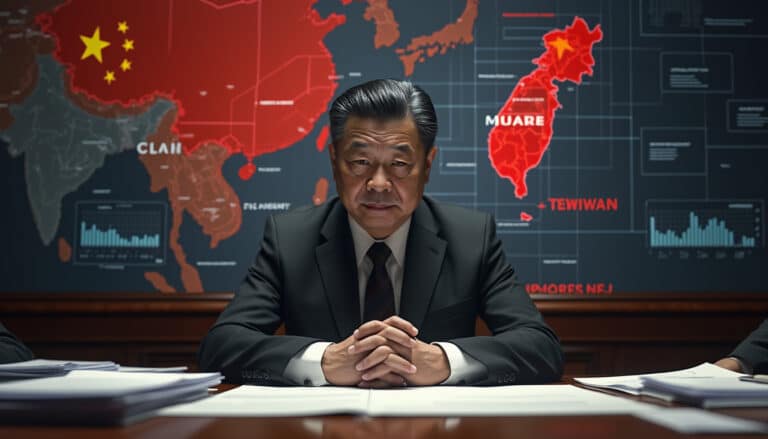The United States and Australia strengthen their strategic alliance. New military agreements seal an unprecedented cooperation. This collaboration aims to ensure security in a region under growing tension.
In a context marked by China’s increasing aggression in the South China Sea, the two nations are joining forces to strengthen their military presence. With these new agreements, the United States will gain expanded access to bases located on the west and north coasts of Australia. This strategic initiative allows for better maritime surveillance and increased responsiveness to regional threats.
Among the bases involved, the Royal Australian Air Force Base Learmonth on the west coast, as well as the bases Scherger and Curtin on the north coast, will be at the heart of joint operations. This expansion will allow the deployment of maritime patrol aircraft and reconnaissance planes, thereby enhancing detection and rapid response capabilities. Additionally, the two countries are committing to closely cooperate in the construction and development of armaments, including the Guided Multiple Launch Rocket System (GMLRS) and the Precision Strike Missile (PrSM).
The establishment of a new joint programs office in Huntsville, Alabama, will facilitate the coordination of ammunition production and maintenance efforts. This initiative is a continuation of the AUKUS agreement signed three years ago, which has already enabled increased technological sharing among the three allied nations. The Biden administration aims to consolidate its strategy in the Asia-Pacific region, relying on sustainable and effective collaborations.
Despite political uncertainties, whether in the United States with upcoming elections or in Australia with potentially fragmented ballots, the bilateral relationship remains strong. Analysts believe that the threat posed by China provides a clear direction for these partnerships, favoring the swift implementation of new initiatives. This alliance, described by the U.S. Secretary of Defense as a “staunch alliance”, promises to play a key role in maintaining regional stability.

Table des matières
ToggleWhat are the new military agreements between the United States and Australia?
The United States and Australia have just unveiled new agreements aimed at strengthening their cooperation in military deployment and armament development. These agreements are part of the Biden administration’s strategy to consolidate U.S. presence in the Asia-Pacific region, an increasingly sensitive area facing rising tensions with China. One of the main aspects of these agreements involves increasing U.S. access to bases located on the west and north coasts of Australia.
For several years, the United States has been investing hundreds of millions of dollars into military construction in Australia, particularly due to the strategic proximity of these bases to the South China Sea. This region has become a theater of increased military actions from Beijing, making collaboration with Australia essential to maintaining regional balance. The United States will now be able to operate from the Royal Australian Air Force Base Learmonth on the west coast, as well as reinforce its presence at the Scherger and Curtin bases, located at different points on the north coast.
What impact will these new deployments have on regional security?
The increase in U.S. military presence in Australia will have a significant impact on regional security. By allowing more maritime patrol and reconnaissance aircraft to operate from Australian bases, the United States is enhancing its ability to monitor and respond quickly to potential threats in the area. This includes surveillance of China’s naval and aerial activities in the South China Sea and beyond.
U.S. Secretary of Defense Lloyd Austin highlighted in a press conference that these initiatives would allow for better maritime surveillance and a more effective response to incidents. This increased orchestration of U.S. military resources will help deter any aggressive actions and maintain stability in a key region for international trade and overall security.
How do these agreements strengthen collaboration in armaments?
In addition to military deployments, the United States and Australia have announced plans for closer collaboration in the field of armaments. The two countries will work together to build, maintain, and develop weapons such as the Guided Multiple Launch Rocket System (GMLRS) and the Precision Strike Missile (PrSM). These precision weapons are essential for providing advanced strike capabilities, thus meeting strategic needs in an increasingly complex geopolitical environment.
The initial phases of this partnership include the assembly of the first munition and joint production of the second by December. This collaboration will be coordinated by a new joint programs office that will be established in Huntsville, Alabama, next year. This initiative is part of the AUKUS agreement, signed three years ago between the United States, the United Kingdom, and Australia, aimed at sharing advanced technologies, including nuclear-powered submarines.
What is the geopolitical context behind these new deployment plans?
These new military deployment and armament plans between the United States and Australia are set against a geopolitical backdrop marked by China’s rise and heightened competition in the Asia-Pacific region. China has intensified its military activities in the South China Sea, seeking to expand its influence and assert its maritime supremacy. This situation has prompted the United States to reinforce its alliances and establish new partnerships to counter this rise.
The AUKUS agreement, which has already significantly enhanced Australia’s military capabilities, serves as a foundation for these new agreements. By expanding American military bases in Australia and intensifying collaboration in armaments, the United States aims to establish a more robust and sustainable presence in the region. This strategy aims not only to deter China but also to reassure long-standing allies and partners by demonstrating a strong commitment to collective security.
What are the implications for U.S.-Australia relations?
The new military and armament agreements further strengthen the relations between the United States and Australia, already regarded as an “unbreakable alliance” by U.S. Secretary of Defense Lloyd Austin. This close collaboration reflects mutual trust and a shared commitment to regional security. Despite potential political changes in the United States or Australia, the strength of this alliance remains crucial for both nations.
The Australian Enterprise Institute emphasizes that the Biden administration has intensified its efforts to deepen and expand its alliances in the region, and these new agreements are further evidence of this strategy. Despite political uncertainties, particularly the upcoming U.S. elections in November and the Australian elections in September, the ties between Washington and Canberra remain strong, bolstered by a common goal of maintaining a balance of power against China.
Furthermore, ongoing cooperation in the construction and development of armaments shows a willingness to collaborate not only militarily but also technologically, creating a beneficial synergy for both countries. This cooperation could also pave the way for future partnerships in other areas of defense and international security.
What are the potential challenges of this strengthened cooperation?
Despite the obvious advantages of this strengthened cooperation, several potential challenges could hinder its effective implementation. One of the main challenges lies in the logistical and administrative coordination between the two nations, especially with the opening of the new joint programs office in Huntsville, Alabama. Ensuring smooth communication and effective resource management will be crucial to avoid delays and conflicts in joint projects.
Another major challenge relates to political uncertainties. The upcoming elections in the United States and Australia could introduce unpredictable variables, particularly if more skeptical political parties regarding the American alliance come to power. However, the depth of the alliance and shared strategic interests should allow for continuity despite internal political changes.
Moreover, the technological complexity of new armaments such as the GMLRS and the PrSM requires close collaboration in research and development. The two countries will need to invest in technology transfer and ensure that quality and safety standards are rigorously met. This necessitates total transparency and a shared commitment to operational excellence.
How does this collaboration fit into the broader framework of global defense?
The collaboration between the United States and Australia in military deployment and armament development fits into a global defense strategy aimed at creating a balance of forces in strategic areas of the globe. By strengthening their presence in the Asia-Pacific, the two nations seek to prevent conflicts and promote international governance based on clear and fair rules.
This initiative is accompanied by partnerships with other allies and international partners, as evidenced by recent collaborations between the United Kingdom, Italy, and Japan to develop management plans for next-generation fighters. Furthermore, investing in advanced technologies, such as the M10 Booker fire support vehicle deployed by the U.S. Army in anticipation of a future presence in the Arctic, demonstrates a proactive approach to addressing emerging security challenges.
Additionally, leading defense companies, such as BAE Systems, play a key role in this strategy by providing cutting-edge technologies and initiating projects for advanced warship construction, thus strengthening the military capabilities of allies. This synergy between governments and defense industries creates a robust ecosystem capable of addressing current and future threats.
What is the international reaction to these new plans?
The international community is watching closely the new military deployment and armament plans between the United States and Australia. While some allies see this move as a necessary fortification against China’s rise, others may express concerns about an arms race and escalating tensions. The strengthening of U.S. military capabilities in Australia is viewed by some as a clear sign of a new era of geopolitical competition.
In this context, countries such as Turkey and Indonesia have also strengthened their collaboration in armaments, illustrated by a new troop transport. This global dynamic demonstrates a strategic repositioning where several nations seek to solidify their alliances and increase their military capabilities in response to international uncertainties.
Moreover, initiatives from startups in the defense sector, such as DefTech Zulu Defence System, which recently raised $750,000 in a seed round via Finvolve, also demonstrate a growing interest in technological innovation in defense. These companies bring innovative solutions that can complement traditional military efforts and offer additional strategic advantages.
What are the future prospects for this alliance?
The future prospects for the alliance between the United States and Australia appear promising, with a clear direction towards strengthened cooperation and deeper integration of defense strategies. The relationship is marked by ambitious projects and deployment plans that aim not only to address current challenges but also to anticipate future developments in the geopolitical landscape.
The ongoing commitment of both nations to research and develop advanced armaments, as well as the expansion of U.S. military presence in Australia, lays the groundwork for a sustainable alliance capable of adapting to changes and new threats. This adaptability is essential in a world where security issues are constantly evolving, necessitating increased flexibility and responsiveness.
Furthermore, the support from defense industries and innovative entrepreneurial initiatives helps solidify this alliance, ensuring a robust technological base and a continuous capacity for innovation. With industrial partners like BAE Systems and startups like DefTech Zulu Defence System, the alliance benefits from a diverse ecosystem that supports the growth and development of military capabilities.
Finally, how this alliance is perceived and supported internationally will play a crucial role in its sustainability. By promoting transparent initiatives and seeking collaborations with other nations sharing similar interests, the United States and Australia can strengthen their global position and ensure lasting stability in the Asia-Pacific region and beyond.
What are the economic stakes related to these new deployments?
The new military deployments and collaboration in armaments between the United States and Australia also have significant economic implications. These initiatives generate massive investments in military infrastructure, thereby creating opportunities for local industries and defense sector companies. For example, the U.S. Army is launching tests of the M10 Booker fire support vehicle, which could stimulate the production and maintenance of such vehicles in Australia.
Additionally, the construction of new military bases and the expansion of armament projects involve the employment of thousands of workers and the creation of contracts for local and international businesses. This contributes not only to the Australian economy in terms of job creation and technological development but also to that of the United States through the ordering of materials and services.
Strengthened military alliances can also stimulate technological innovation. Companies that participate in the development of new weapons and defense systems, like DefTech Zulu Defence System, benefit from funding and opportunities to develop cutting-edge technologies, which can have positive spillover effects on other industrial sectors.
How does this initiative influence other military alliances?
The enhanced initiative between the United States and Australia can serve as a model for other global military alliances. By demonstrating the benefits of close cooperation in military deployment and armament development, this alliance encourages other countries to strengthen their own partnerships. For example, countries like the United Kingdom, Italy, and Japan have joined forces to develop a management plan for the next-generation fighter program, thus showing a trend towards more integrated and collaborative alliances.
This dynamic may encourage greater integration of armed forces at the international level, facilitating the sharing of intelligence, military coordination, and joint development of advanced technologies. This would strengthen global stability and allow for a more effective response to multidimensional threats, whether military, cyber, or economic in nature.
Furthermore, the expansion of these alliances may also influence the strategies of neutral or non-aligned countries, prompting them to adopt more robust defense policies to address new geopolitical realities. This creates an environment where international cooperation becomes a strategic necessity, fostering a collective approach to global challenges.























